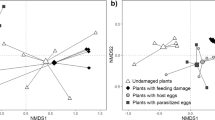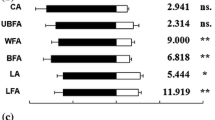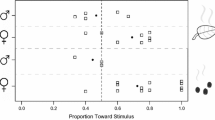Abstract
Locating potential hosts for egg laying is a critical challenge in the life history of many insects. Female insects in several orders have evolved mechanisms to find hosts by using olfactory and visual signals derived from their hosts. We describe visual and chemical cues used by the dipteran parasitoid Apocephalus paraponerae (Diptera: Phoridae) in the location and acceptance of its host ant Paraponera clavata (Hymenoptera: Formicidae: Ponerinae). Our results show that A. paraponerae uses the visual cue of ant body size when locating hosts at short range and that these flies lay more eggs in ants that retain their surface chemicals than in ants with these chemicals removed. We compare the cues used by A. paraponerae with cues used by tephritid fruit flies in location and acceptance of their hosts, and we suggest further avenues for the study of host location, acceptance, and host discrimination of A. paraponerae and other parasitoids of ants.
Similar content being viewed by others
REFERENCES
Aldrich, J. R., Oliver, J. E., Lusby, W. R., Kochansky, J.P., and Lockwood, J. A. (1987). Pheromone strains of the cosmopolitan pest, Nezara viridula (Heteroptera: Pentatomidae). J.Exp. Zool. 244: 171-175.
Aldrich, J. R., Hoffmann, M. P., Kochansky, J. P., Lusby, W. R., Eger, J. E., and Payne, J. A. (1991). Identification and attractiveness of a major pheromone component for Nearctic Euschistus spp stink bugs (Heteroptera: Pentatomidae). Environ. Entomol. 20: 477-483.
Aluja, M., and Prokopy, R. J. (1992). Host search behavior by Rhagoletis pomonella flies: Intertree movement patterns in response to wind-borne fruit volatiles under field conditions. Physiol. Entomol. 17: 1-8.
Aluja, M., and Prokopy, R. J. (1993). Host odor and visual stimulus interaction during intratree host finding behavior of Rhagoletis pomonella flies. J. Chem. Ecol. 19: 2671-2696.
Arthur, A. P. (1981). Host acceptance by parasitoids. In Nordlund, D. A., Jones, R. L., and Lewis, W. J. (eds.). Semiochemicals: Their Role in Pest Control, John Wiley and Sons, New York, pp. 97-120.
Askew, R. R. (1971). Parasitic Insects, American Elsevier, New York.
Averill, A. L., and Prokopy, R. J. (1988). Factors influencing release of host marking pheromone by Rhagoletis pomonella flies. J. Chem. Ecol. 14: 95-111.
Beehler, J. W., Millar, J. G., and Mulla, M. S. (1993). Synergism between chemical attractants and visual cues influencing oviposition of the mosquito, Culex quinquefasciatus (Diptera: Culicidae). J. Chem. Ecol. 19: 635-644.
Brown, B. V., and Feener, D. H., Jr. (1991a). Behavior and host location cues of Apocephalus paraponerae (Diptera: Phoridae), a parasitoid of the giant tropical ant Paraponera clavata (Hymenoptera: Formicidae). Biotropica 23: 182-187.
Brown, B. V., and Feener, D. H., Jr. (1991b). Life history parameters and description of the larvae of Apocephalus paraponerae (Diptera: Phoridae), a parasitoid of the gaint tropical ant Paraponera clavata (Hymenoptera: Formicidae). J. Nat. Hist. 25: 221-231.
Cade, W. (1975). Acoustically orienting parasitoids: Fly phonotaxis to cricket song. Science 190: 1312-1313.
Carlson, D. A., and Service, M. W. (1980). Identification of mosquitos of Anopheles gambiae species complex A and B by the analysis of cuticular components. Science 207: 1089-1091.
Diehl, S., and Prokopy, R. J. (1986). Host-selection behavior differences between the fruit fly sibling species Rhagoletis pomonella and R. mendax (Diptera: Tephritidae). Ann. Entomol. Soc. Am. 79: 266-271.
Feener, D. H., Jr., and Brown, B. V. (1997). Diptera as parasitoids. Annu. Rev. Entomol. 42: 73-97.
Feener, D. H., Jr., Jacobs, L. F., and Schmidt, J. O. (1996). Specialized parasitoid attracted to a pheromone of ants. Anim. Behav. 51: 61-66.
Godfray, H. C. J. (1994). Parasitoids, Princeton University Press, Princeton, NJ.
Hermann, H. R., Blum, M. S., Wheeler, J. W., Overal, W. L., Schmidt, J. O., and Chao, J.-T. (1984). Comparative anatomy and chemistry of thevenomapparatus and mandibular glands in Dinoponera grandis (Guerin) and Paraponera clavata (F.) (Hymenoptera: Formicidae: Ponerinae). Ann. Entomol. Soc. Am. 77: 272-279.
Hölldobler, B., and Wilson, E. O. (1990). The Ants, Belknap Press, Cambridge, MA.
Howard, R. W., and Blomquist, G. J. (1982). Chemical ecology and biochemistry of insect hydrocarbons. Annu. Rev. Entomol. 27: 149-172.
Monteith, L. G. (1956). Influence of host movement on selection of hosts by Drino bohemica Mesn. as determined by an olfactometer. Can. Entomol. 88: 853-856.
Owens, E. D., and Prokopy, R. J. (1986). Relationship between reflectance spectra of host plant surfaces and visual detection of host fruit by Rhagoletis pomonella flies. Physiol. Entomol. 11: 297-308.
Prokopy, R. J. (1972). Response of apple maggot flies to rectangles of different colors and shades. Environ. Entomol. 1: 720-726.
Prokopy, R. J., and Bush, G. L. (1973). Ovipositional responses to different sizes of artificial fruit by flies of the Rhagoletis pomonella species group. Ann. Entomol. Soc. Am. 66: 927-929.
Prokopy, R. J., Moericke, V., and Bush, G. L. (1973). Attraction of apple maggot flies to odor of apples. Environ. Entomol. 2: 743-749.
Sokal, R. R., and Rohlf, F. J. (1981). Biometry, W. H. Freeman, New York.
van Alphen, J. J. M., and Vet, L. E. M. (1986). An evolutionary approach to host finding and selection. In Waage, J., and Greathead, D. (eds.). Insect Parasitoids, Academic Press, London, pp. 23-61.
Vander Meer, R. K., and Wojcik, D. P. (1982). Chemical mimicry in the myrmecophilous beetle Myrmecaphodius excavaticollis. Science 218: 806-808.
van Lenteren, J. C. (1981). Host discrimination by parasitoids. In Nordlund, D. A., Jones, R. L., and Lewis, W. J. (eds.), Semiochemicals: Their Role in Pest Control, John Wiley and Sons, New York, pp. 153-179.
Vinson, S. B. (1981). Habitat location. In Norlund, D. A., Jones, R. L., and Lewis, W. J. (eds.), Semiochemicals: Their Role in Pest Control, John Wiley and Sons, New York, pp. 51-77.
Vinson, S. B. (1984). How parasitoids locate their hosts: A case of insect espionage. In Lewis, T. (ed.), Insect Communication, Royal Entomological Society of London, London, pp. 325-348.
Walker, T. J. (1993). Phonotaxis in female Ormia ochracea (Diptera: Tachinidae), a parasitoid of field crickets. J. Insect Behav. 6: 389-410.
Waloff, N., and Jervis, M. A. (1987). Communities of parasitoids associated with leaf hoppers and plant hoppers in Europe. Adv. Ecol. Res. 17: 281-376.
Winston, M. L. (1992). Semiochemicals and insect sociality. In Roitberg, B.D., and Isman, M. B. (eds.), Insect Chemical Ecology: An Evolutionary Approach, Chapman & Hall, New York, pp. 315-333.
Author information
Authors and Affiliations
Rights and permissions
About this article
Cite this article
Morehead, S.A., Feener, D.H. Visual and Chemical Cues Used in Host Location and Acceptance by a Dipteran Parasitoid. Journal of Insect Behavior 13, 613–625 (2000). https://doi.org/10.1023/A:1007875921705
Issue Date:
DOI: https://doi.org/10.1023/A:1007875921705




